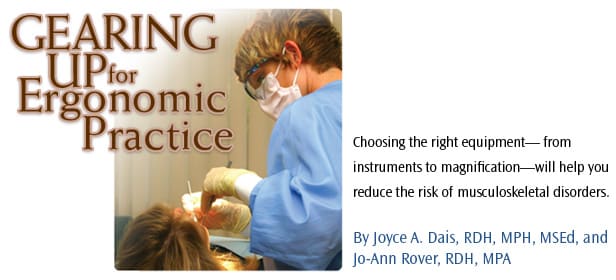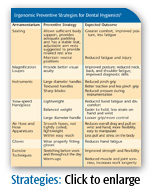
Gearing Up for Ergonomic Practice
Choosing the right equipment—from instruments to magnification—will help you reduce the risk of musculo skeletal disorders.
Musculoskeletal disorders are an important consideration for dental professionals as they can cut short a fulfilling career. In the United States alone, the annual cost of musculoskeletal disorders is between $45 and $54 billion and they represent approximately 40% of compensated injuries.1
Work-related musculoskeletal disorders, repetitive stress injuries, and cumulative trauma disorders are attributed to poor ergonomics. Carpal tunnel syndrome is a cumulative trauma disorder that has affected dental hygienists in particular for years. Hand, wrist, neck, and back problems are also commonplace in the practice of dental hygiene.
The major contributors to work-related musculoskeletal disorders include performing procedures that require repetitive and fixed postures such as static loading when the body is placed in one position for a prolonged period of time while working, having limited work space that restricts and compromises the clinician’s posture and body movements, and continuous strain placed on the neck and muscles.2
INSTRUMENT USAGE
Incorrect use of instruments, like using a grasp that is too tight or an improper fulcrum or finger rest, is a significant cause of ergonomic problems and must be avoided. Dong et al3 report that the use of finger rests can reduce muscle load of the hand, thus avoiding injuries that may be caused by muscle fatigue. Finger rests are also important in stabilizing instruments during scaling procedures.3 Dental hygienists should keep instruments sharpened to prevent handfatigue related illnesses, such as carpal tunnel syndrome. Blunt instruments force the clinician to work harder to achieve results, thus placing additional stress on the hand.
Force can increase the risk of injury to the hand if the grip is too tight.4 Instruments with larger handle diameters require less force than an instrument with a more slender diameter. Also, textured handles provide greater traction, decreasing the pinch grip. When less grip is required, the operator is able to grasp the instrument more loosely while still maintaining control.5 Newer instruments are being designed with larger handles that have grooves to reduce slippage and improve overall grip.6
During scaling procedures, the dental hygienist should focus on keeping the hand and wrist in a neutral position. Repetitive movements caused by flexing or extending the wrist can cause inflammation and trauma to the musculoskeletal system.4 Ultrasonic scalers, when used properly, require a lighter grip and less force during scaling procedures, thereby reducing potential fatigue, wear, and muscle strain.7
Instruments, handpieces, air-water syringes, and suction hoses should be positioned within easy reach during treatment procedures to help avoid any unnecessary strain on the hand and wrist and to reduce the potential of extra weight, pull, or drag on the body created by heavy, rigid equipment.1
STOOLS
Good posture is essential to preventing musculoskeletal disorders. Dental hygienists should practice positioning their entire bodies so that their weight is distributed evenly on the chair seat. Unnecessary bending or twisting should be avoided as much as possible while maintaining neutral arm and wrist positions.
The operator seat should provide sufficient body support for the thighs, legs, arms, and back. Newly designed operator stools are more ergonomic and should help prevent back problems. Stools designed to automatically correct an operator’s seating position and to create proper balance are currently available. These stools are designed to increase comfort and encourage better posture, blood circulation, and improved respiration.
Magnification
Another support mechanism for avoiding musculoskeletal disorders is magnification loupes. Loupes provide the operator with better visual acuity when performing precise diagnostic procedures in the oral cavity— reducing physical stressors associated with these demanding tasks.8 Wearing loupes during clinical dental hygiene procedures is recommended for reducing strain on the eyes and improving body posture. While magnification is reported to improve visual acuity, studies show that greater motor control is also provided, thus enhancing the ability to perform quality diagnostic assessments and improve patient treatment outcomes.9
By improving visibility, the need for bending and twisting of the neck in an attempt to see well is reduced. Proper selection of loupes is important for preventing poor postures that may increase the risk of developing neck, shoulder, and back pain.10
A variety of magnification loupes are available that address individual preference and needs. As loupes are becoming more widely used among dental hygienists, they are being designed with features to ensure better ergonomics and more comfortable working positions. Improved features include loupes that are lightweight and offer a wide field of view and high depth of field.
CONCLUSION
Consistency in practicing proper posture and ergonomics while performing dental hygiene procedures is extremely important. Plus, selecting appropriate products and using efficient instruments and equipment at all times during dental hygiene procedures will promote a better sense of wellbeing, enhance productivity, and increase overall longevity and prosperity in the career of dental hygiene.
REFERENCES
- Denis D, St-Vincent M, Imbeau D, Jetté C, Nastasia I. Intervention practices in musculo skeletal disorder prevention: a critical literature review. Appl Ergon. 2008;39:1-14.
- Oberg T. Ergonomic evaluation and construction of a reference workplace in dental hygiene: a case study. J Dent Hyg. 1993;67:262-267.
- Dong H, Barr A, Loomer P, Rempel D. The effects of finger rest positions on hand muscle load and pinch force in simulated dental hygiene work. J Dent Educ. 2005;69:453-460.
- Barnes CM, Hlava GL. Ergonomics—a buzz word. The Preventive Angle. 2002;1(1):1-5.
- Guignon AN. Ergonomics. In: Cooper MN, Weich man L. Essentials of Dental Hygiene. Upper Saddle River, NJ: Pearson Prentice Hall; 2005:174-194.
- Patent Storm. Dental instruments with large molded handles. Available at: www.patentstorm.us/patents/5816806-fulltext.html. Accessed March 21, 2008.
- Turchetta A. Simplifying scaling and root planing with ultrasonics. Dental CE Digest. 2007;4:1:4-6
- Osuna T. Magnification use in dental hygiene. Access. 2003;17(1):2-8.
- Semler SW. The eyes have it! Journal of Practical Hygiene. 2007;16:7:12-13.
- Chang BJ, Chang M, Greztinger H. Loupes: an invaluable career investment for the hygienist. Journal of Practical Hygiene. 2006;15:7:13-15.
From Dimensions of Dental Hygiene. April;6(4): 30-32.


